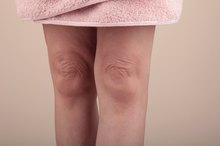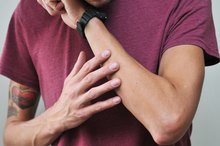How to Get Rid of Stretch Marks on the Back of the Knees
Stretch marks appear virtually all over the body, with most instances on the back of the knees, thighs, stomach and arms. This is caused by rapid expansion of the skin, harming the natural elasticity that keeps the skin youthful looking. Stretch marks on the back of the knees can make it difficult to wear shorts or skirts without worrying about the appearance of your legs.
Exercise your legs to target stretch marks. This helps tone the skin while building the muscles and fading stretch marks. Lie on the floor on your side. Rest your head on the arm nearest the floor and place your upper hand on the floor at your waist, palm down. With legs straight and toes pointed, raise the upper leg slowly till it is hip level. Hold for the count of five and lower back to the floor. Do 15 repetitions, then switch sides and work the other leg.
How to Smooth Out Wrinkles Above the Knee
Learn More
Apply a cream containing aloe vera and vitamin E, according to NaturalPregnancy.com. Massage a dime-sized amount into the stretch marks in a circular motion. The massage action stimulates blood flow while the aloe vera and vitamin E promote skin cell regeneration and collagen fiber production, improving skin elasticity.
Lose weight to fade stretch marks. When carrying excess weight, constant pressure is put on the skin, worsening stretch marks and forming new ones. Losing weight through diet and exercise will help them to fade and prevent new ones. Eat a healthy diet consisting of plenty of fresh fruits and vegetables, which contain antioxidants that support skin and hair health.
How to Keep Skin Tight During Weight Loss
Learn More
Drink eight to ten glasses of water per day. Water keeps the skin moisturized from the inside out while flushing out toxins that can harm the skin by causing skin cell breakdown. Water keeps the skin plump and moisturized and helps fade stretch marks while supporting the skin's natural healing process.
Related Articles
References
- Farahnik B, Park K, Kroumpouzos G, Murase J. Striae gravidarum: Risk factors, prevention, and management. Int J Womens Dermatol. 2017;3(2):77-85. doi:10.1016/j.ijwd.2016.11.001
- Wollina U, Goldman A. Management of stretch marks (with a focus on striae rubrae). J Cutan Aesthet Surg. 2017;10(3):124-129. doi:10.4103/JCAS.JCAS_118_17
Writer Bio
Sharin Griffin has been a freelance writer since 2009, specializing in health-related articles. She has worked in the health-care industry as a certified nursing assistant and medical technician. Griffin's medical expertise encompasses bariatrics and geriatric care, with an emphasis on general medicine. She is completing an associate degree in health-care administration from Axia University.









